Mitsubishi Mirage (2022 year). Manual in english - page 2
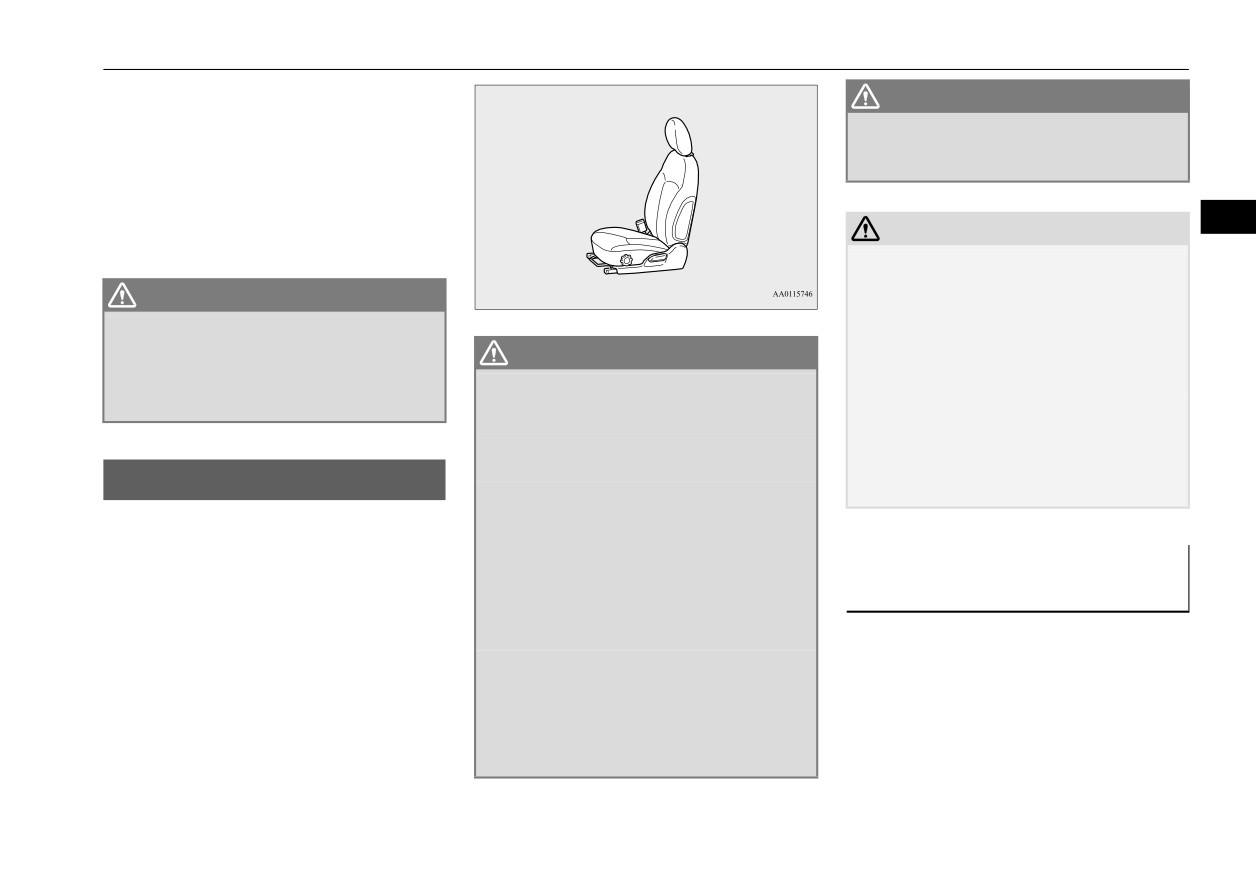
Front seats
z That seatbacks are upright, with head
WARNING
restraints properly adjusted.
z
Always place children 12 years old and
under in the rear seat and use appropriate
Safety equipment cannot prevent injury or
child restraint systems.
death in all motor vehicle accidents. How-
ever, you can help reduce the risk of injury or
death by following the instructions in this
4
CAUTION
manual.
z
Make sure that the seat is adjusted by an
adult. If it is adjusted by a child, an unex-
WARNING
pected accident might occur.
z Do not place objects under the seats. This
z
Do not place a cushion or the like between
could prevent the seat from locking
your back and the seatback while driving.
WARNING
securely, and it could lead to an accident.
The effectiveness of the head restraints will
It may also cause damage to the seat or
z
Do not attempt to adjust the seat while
be reduced in the event of an accident.
other parts.
driving. This can cause loss of vehicle con-
z
When sliding the seats, be careful not to
trol and result in an accident.
catch your hand or leg.
z
After adjusting the seat, make sure that
z
When sliding or reclining the seat rearward,
seat is securely locked into position.
pay careful attention to the rear seat passen-
Front seats
z
To reduce the risk to the driver of serious
gers.
N00401800403
injury or death during deployment of the
Position the driver’s seat as far back as possi-
driver’s airbag, always properly wear the
ble while maintaining a position that still
seat belt and adjust the driver’s seat as far
To adjust the seat forward or
back as possible while maintaining a posi-
enables you to fully apply the pedals, easily
tion that still enables you to fully apply the
backward
control the steering wheel and safely operate
pedals, easily control the steering wheel,
N00401900316
the vehicle.
and safely operate the vehicle.
Pull the seat adjusting lever up and slide the
z
To reduce the risk to the front passenger
seat forward or backward to the desired posi-
of serious injury or death during deploy-
tion. Release the adjusting lever to lock the
ment of the passenger’s airbag, always
seat in place.
properly wear the seat belt and adjust the
front passenger’s seat as far back as possi-
ble.
Seat and restraint systems
4-3
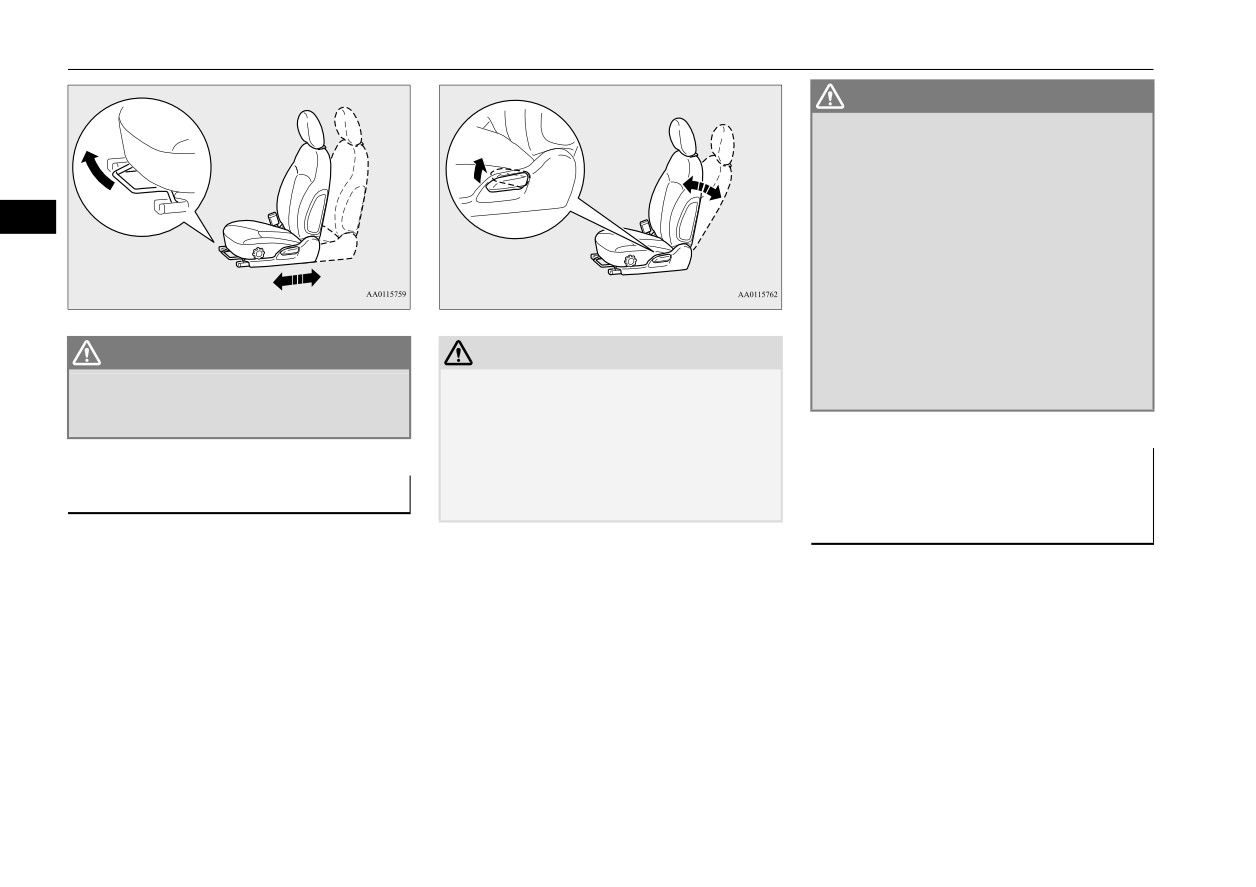
Front seats
WARNING
z
To reduce the risk of serious injury or
death in the event of an accident or sud-
den stop, all seatbacks should be kept in
the upright position while the vehicle is in
motion.
4
Seat belt performance during an accident
can be adversely affected if the seatbacks
are reclined. The more a seatback is
reclined, the more likely seat belt perfor-
mance will be adversely affected. If the
seat belt is not properly positioned against
WARNING
CAUTION
the body during an accident, there is
increased risk you will slide under the belt
z
To make sure that the seat is securely
z
The reclining mechanism used in the seat-
and receive serious injury or death.
locked, try to move it forward or back-
back is spring loaded, and will cause the
ward without using the adjusting lever.
seatback to return quickly to the vertical
position when the lock lever is operated.
When pulling the lever, sit close to the seat-
To adjust the seat height
back or hold the seatback with your hand to
To adjust the seatbacks
(Driver’s seat only, if so
control its return motion.
N00402000369
equipped)
To adjust the seatback, lean forward slightly,
N00402100243
gently pull the seatback lock lever up, then
To adjust the seat height, turn the dial as
lean backward to a comfortable position and
shown in the illustration.
release the lever. The seatback will lock in
place.
4-4
Seat and restraint systems

Front seats
NOTE
WARNING
z Do not stand or sit on the arm rest. It could
z
Persons who are unable to feel tempera-
break.
ture change or skin pain due to age, ill-
ness, injury, medication, alcohol use,
fatigue or other physical conditions or
who have sensitive skin may suffer burns
Heated seats (if so equipped)
4
when using the heated seat even at low
N00435601476
temperatures. To reduce the risk of burns,
The heated seats can be operated by pushing
people with such conditions must use care
the switch when the ignition switch or the
when using the heated seat.
operation mode is in ON. The indicator light
1- To move the seat cushion up
(A) will illuminate while the heater is on.
2- To move the seat cushion down
CAUTION
z
Switch off the heated seats when not in use.
Operate the heaters at the “HI” position for
Arm rest (Driver’s seat only, if
quick heating. After the seat has become
warm, set the heater switch to the “LO” posi-
so equipped)
tion to keep it warm. Slight variations in the
N00402301079
seat temperature may be felt while using the
To adjust the arm rest angle, tip the arm rest
heated seats. This is caused by the operation
forward and then raise it to the desired posi-
of the heater’s internal thermostat and does
tion. To release the arm rest angle, raise it
not indicate a malfunction.
fully reward as shown.
z
Do not place heavy objects on the seat or
stick pins, needles, or other pointed objects
into the seat.
1 (HI) -
Heater high
z
Do not place a blanket, cushion, or other
(for quick heating)
insulating material on the seat while using
2 (neutral position) -
Heater off
the heater; doing so can cause the heater ele-
3 (LO) -
Heater low
ment to overheat.
(to keep the seat
z
When cleaning the seat, do not use benzine,
warm)
kerosene, gasoline, alcohol, or other organic
solvents; doing so can cause damage not
only to the surface of the seat, but also to the
heater.
Seat and restraint systems
4-5
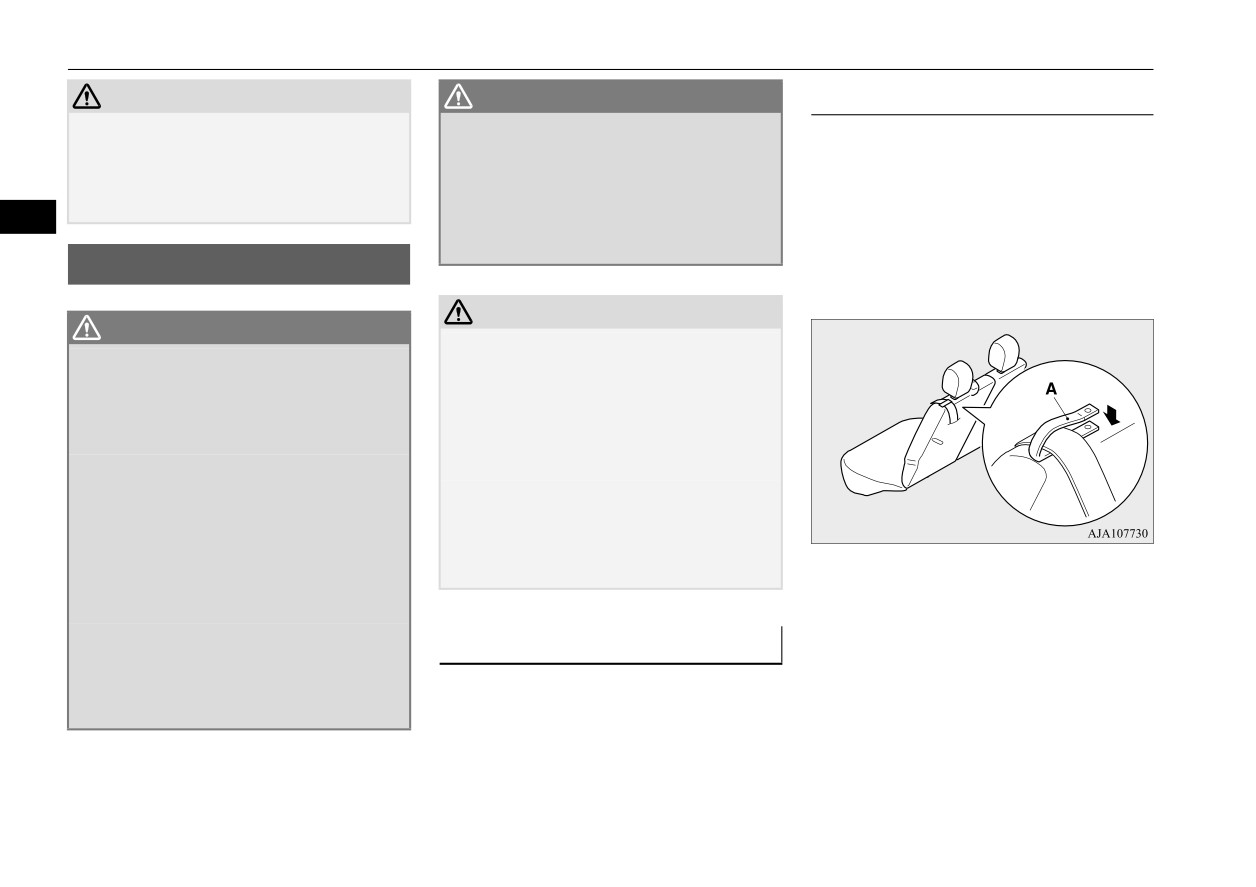
Rear seats
CAUTION
WARNING
To fold
z If water or any other liquid is spilled on the
z
The cargo area in the rear of the vehicle
1. Place each head restraint in its lowest
seat, allow it to dry thoroughly before
should never be used as a play area by
attempting to use the heater. Turn the heater
children. All children should be properly
position. (Refer to “Head restraints” on
off immediately if it appears to be malfunc-
restrained in a restraint device that offers
page 4-7.)
tioning during use.
the maximum protection for their size and
2. Make sure that the seat belt for the out-
4
age. Refer to “Child restraint systems” on
board seating position is passed through
page 4-15.
the seat belt guide strap (A) and the seat
Rear seats
belt guide is fastened as shown in the
N00402500221
illustration.
CAUTION
WARNING
z
In the cargo area, do not load luggage or
z
Never adjust the seats to make a cargo
cargo higher than the top of the seats and
area when the vehicle is in motion or on a
make sure that it is firmly secured. Restricted
slope. The seats could move more than
rear vision or flying objects entering the pas-
necessary or move suddenly causing a
senger compartment during sudden braking
serious accident and/or injury.
could result in a serious accident and/or
z
After folding down a seat or returning a
injury.
seat back to its original position, make
z
Seatbacks should always be folded and put
sure the seat is firmly secured. Also check
back into their normal position by an adult.
to make sure that the seat belts are in
z
When adjusting the seats, be careful not to
front of the seatbacks, and not caught
catch your hand. Personal injury could
behind the seatbacks. If the seat is not
result.
3. Pull the left or right release straps (B), and
secured, it could move causing a serious
fold the rear seatbacks forward.
accident and/or injury.
z
Do not allow anyone to ride in the cargo
area while the vehicle is in motion. People
Folding the seatbacks forward
who are not properly seated and
N00402901222
restrained can be seriously injured or
The rear seatbacks can be folded forward to
killed in an accident.
provide additional luggage compartment
space.
4-6
Seat and restraint systems
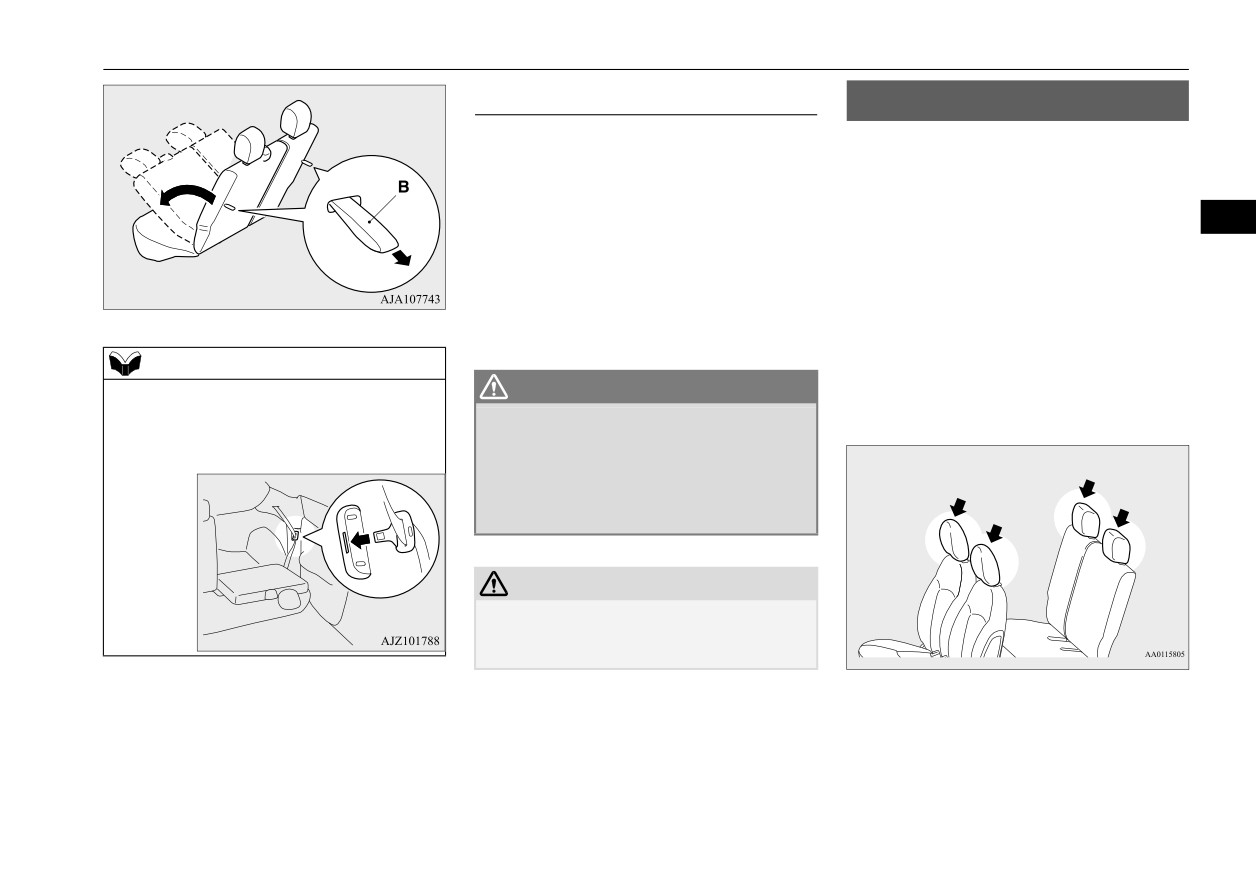
Head restraints
To return
Head restraints
N00404300584
1. Make sure that the seat belt for the out-
Padded head restraints for the seats can
board seating position is passed through
reduce the risk of a whiplash injury if your
the seat belt guide or the seat belt latch
vehicle is hit from the rear.
plate for the outboard seating position is
The head restraints are equipped in the illus-
4
stored.
trated position.
2. Raise the seatback until it locks securely
To maximize the effectiveness of your head
into place.
restraint, adjust the front seatback to the
After returning the seatback to its normal
upright position, the rear seatback to the nor-
position, gently shake the seat and seat-
mal seating position, and the head restraint to
back to make sure they are firmly secured.
the proper position. Sit back against the seat-
NOTE
back with your head close to the head
z
If the seat belt interferes with luggage, unfas-
WARNING
restraint.
ten the seat belt guide to release the seat belt
z After returning the seatbacks to their
and store the seat belt latch plate as shown in
upright positions, make sure that the seat-
the illustration.
backs are locked in place and firmly.
Also check to be sure that the rear seat
belts are in front of the seatbacks, and not
caught behind the seatbacks.
CAUTION
z Do not grab the seat belt guide to raise the
seatback; doing so can cause damage of the
seat belt guide and the seatback.
Seat and restraint systems
4-7
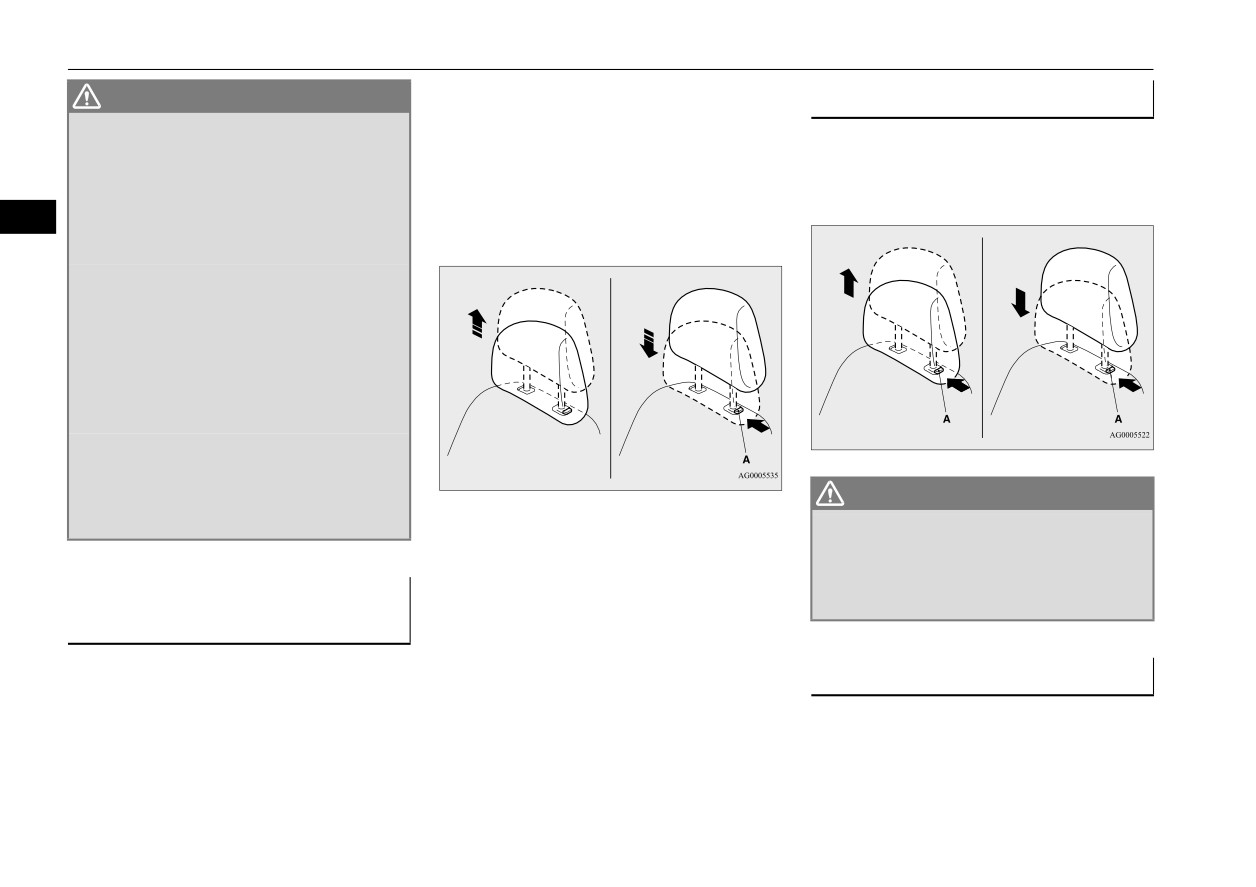
Head restraints
z
To raise the restraint, pull it straight up.
WARNING
To remove
z
To lower the restraint, push down on it
z
Driving without the head restraints in
while pressing the lock knob (A) in the
place can cause you and your passengers
Press the lock knob
(A) in the
direction
direction shown by the arrow.
serious injury or death in an accident. To
shown by the arrows. Then pull
the
head
z
After adjusting the height, push down on
reduce the risk of injury in an accident,
restraint up and out of the seatback.
the restraint to make sure it is locked in
always make sure the head restraints are
4
position.
installed and properly positioned when
the seat is occupied.
z
In order to minimize the risk of a neck
injury due to a rear impact, the front seat-
back must be adjusted to the upright posi-
tion, the rear seatback to the normal
seating position, and the head restraint to
the proper position before vehicle opera-
tion. The driver should never adjust the
seat while the vehicle is in motion.
z
Never place a cushion or similar device on
the seatback. This can adversely affect
head restraint performance by increasing
WARNING
the distance between your head and the
restraint.
z
To help minimize the risk of neck injury in
the event of an accident, the head
restraints must be properly installed and
positioned to proper height before vehicle
Adjustment of the head
operation.
restraint height
To reduce the risk of injury in an accident,
To install
adjust the head restraint height so that the
center of the restraint is at your ear level
First check that the head restraint is facing in
when seated. Any person too tall for the
the right direction as shown in the previous
restraint to reach their ear level when seated
illustration, and then insert it into the seat-
should raise the restraint to the highest locked
back. Push the head restraint down while
position.
4-8
Seat and restraint systems
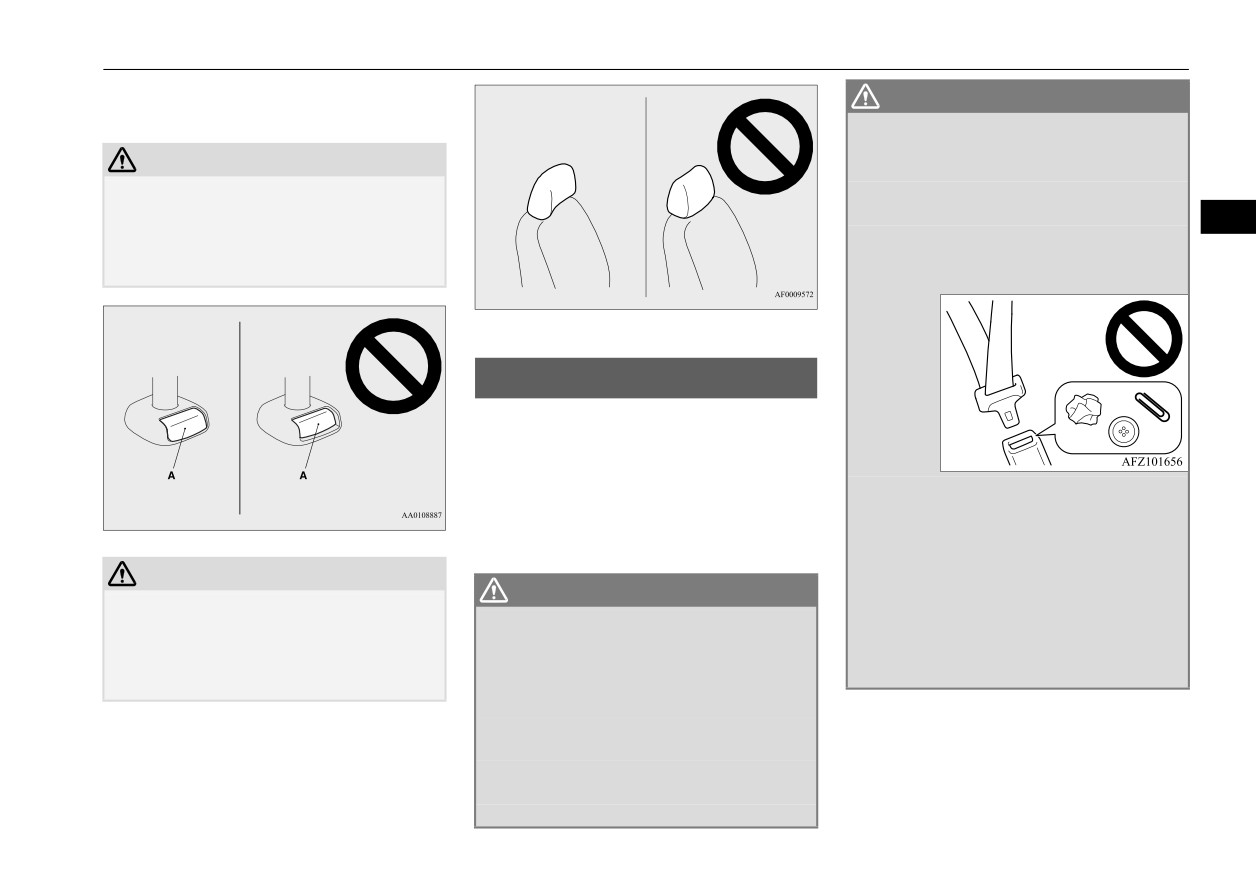
Seat belts
pressing the lock knob (A) until the restraint
WARNING
locks into place.
z Always place the shoulder belt over your
shoulder and across your chest. Never put
CAUTION
it behind you or under your arm.
z Check that the lock knob (A) is extended out
z Always wear the lap belt as low as possible
as shown in the illustration. Then pull the
across your hips, not around your waist.
4
head restraint up to make sure that it is
z Never insert any foreign object, such as a
locked in place and will not come out of the
piece of plastic, paper clip, button or coin,
seatback.
into the seat belt buckle.
Seat belts
N00406001566
Seat belts are installed in your vehicle to help
reduce the risk of injury to the driver and pas-
senger in the event of an accident. Always
z
Never modify or alter the seat belts in
use the provided seat belts.
your vehicle.
Carefully review the following information
z
To reduce the risk to the driver of serious
for proper seat belt usage.
injury or death during deployment of the
driver’s airbag, always properly wear the
CAUTION
WARNING
seat belt and adjust the driver’s seat as far
z
The shape and size of the head restraint dif-
back as possible while maintaining a posi-
fers according to the seat. Always use the
z To help reduce the risk of injury or death
tion that still enables you to fully apply the
correct head restraint provided for the seat
in an accident, seat belts and child
pedals, easily control the steering wheel,
and do not install the head restraint in the
restraint systems must always be used.
and safely operate the vehicle.
wrong direction.
Refer to “Child restraint systems” on page
4-15 for additional information.
z Never use one seat belt for more than one
person.
z Never carry more people in your vehicle
than there are seat belts.
z Always adjust the seat belt for a snug fit.
Seat and restraint systems
4-9
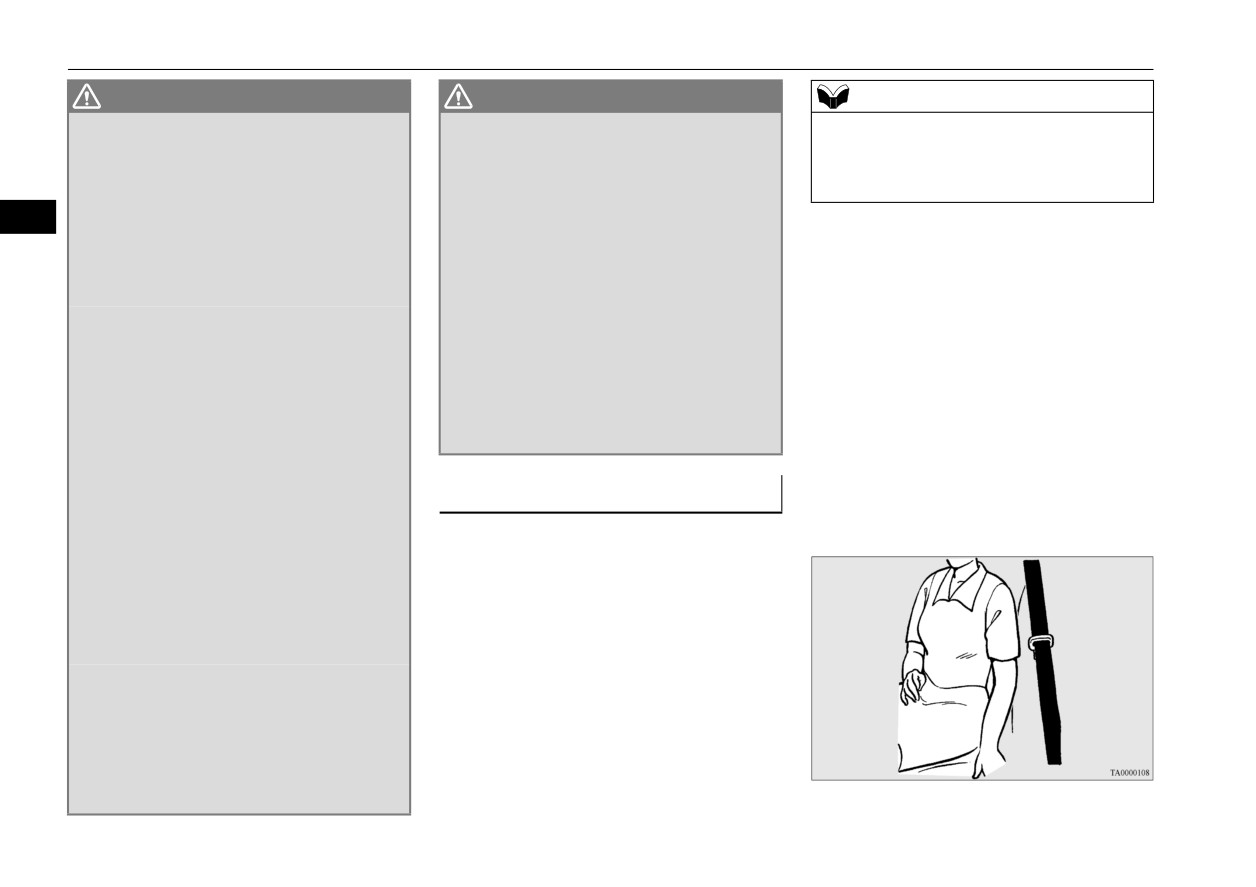
Seat belts
WARNING
WARNING
NOTE
z
To reduce the risk to a front seat passen-
z
In the event of an accident, all seat belt
z For instructions on installing a child restraint
ger of serious injury or death from a
assemblies, including retractors and
system using a seat belt, refer to “Installing a
deploying airbag, make sure the passenger
attachment hardware, should be inspected
child restraint system using the seat belt” on
always wears the seat belt properly,
by an authorized Mitsubishi Motors
page 4-22.
remains seated all the way back and
dealer to determine whether replacement
4
upright in their seat, and moves the seat as
is necessary.
1. Occupants should always sit back in their
far back as possible. Refer to “Supplemen-
z
Do not let children play with the seat belts.
seats with their backs against the upright
tal Restraint System (SRS) - airbag” on
If children play with the seat belts by
seatback. To reduce the risk of serious
page 4-26 for additional information.
wrapping them around their bodies, the
injury or death during deployment of the
z
Never hold an infant or child in your arms
seat belt may retract and become tight.
or on your lap when riding in this vehicle
This can result in a serious injury or
airbag, adjust the driver’s seat as far back
even when you are wearing your seat belt.
death, such as suffocation. This can occur
as possible while maintaining a position
Never place any part of the seat belt you
even if the vehicle is parked. If the child
that still enables you to fully apply the
are wearing around an infant or child.
cannot be released from the seat belt, use
pedals, easily control the steering wheel,
Failure to follow these simple instructions
an appropriate tool such as a knife or scis-
and safely operate the vehicle. The front
creates a risk of serious injury or death to
sors to cut the seat belt.
passenger seat should also be moved as
your child in the event of an accident or
far back as possible. Refer to “Supple-
sudden stop.
Seat belt instructions
mental Restraint System (SRS) - airbag”
z
Children 12 years old and under should
N00406201539
on page 4-26. Also refer to “To adjust the
always ride in the rear seat and be prop-
seat forward or backward” on page 4-3.
erly restrained. This reduces their risk of
All seats are equipped with a seat belt which
serious injury or death in an accident,
uses one combined lap-and-shoulder belt with
especially due to a deploying front passen-
an emergency locking retractor.
ger’s airbag. Refer to “Child restraint sys-
tems” on page
4-15 for additional
This system is designed to provide both com-
information.
fort and safety. It permits full extension and
z
Any child who is too small to properly
automatic retraction of the belts during nor-
wear a seat belt must be properly
mal vehicle operation. A sensing device
restrained in an appropriate child
inside the belt retractor is designed to lock the
restraint system.
retractor in the event of a sudden change in
z
Infants MUST be placed in a rear-facing
the vehicle’s motion.
child safety seat and positioned in the rear
seat.
4-10
Seat and restraint systems

Seat belts
3. Pull the seat belt out slowly while holding
4. The lap part of the belt must always be
WARNING
the latch plate. Push the latch plate into
worn low and snug across the hips. Pull
z
To reduce the risk of serious injury or
the buckle until you hear a “click”. Pull
up on the shoulder portion of the belt to
death in the event of an accident or sud-
up on the belt to be sure the latch plate is
take up any slack in the lap belt.
den stop, all seatbacks should be kept in
locked securely in the buckle.
the upright position while the vehicle is in
motion.
4
Seat belt performance during an accident
can be adversely affected if the seatbacks
are reclined. The more a seatback is
reclined, the more likely seat belt perfor-
mance will be adversely affected. If the
seat belt is not properly positioned against
the body during an accident, there is
increased risk you will slide under the belt
and receive serious injury or death.
2. Grasp the latch plate and slide it up the
NOTE
webbing so that it easily pulls across your
NOTE
z With the exception of the seat belt for the
body.
z If the seat belt locks up and cannot be pulled
driver, the seat belts in all other seating posi-
out, pull it once with force and let it retract
tions are equipped with an Automatic Lock-
all the way.
ing Retractor (ALR) function. If you pull the
Then, pull the belt out slowly once again.
seat belt fully out of the retractor, the retrac-
tor will switch to its ALR child restraint
installation function (see page 4-22).
When the ALR function has been activated,
the seat belt will only retract. If this happens,
let the belt fully retract, then pull the seat
belt back out, repeating steps 1 through 4.
Seat and restraint systems
4-11

Seat belts
WARNING
Driver’s seat belt
WARNING
z Be sure the lap belt portion fits snugly and
reminder/warning light
z
In order to reduce the risk of serious
is worn as low as possible across the hips,
injury or death in an accident, always fas-
N00418400384
not around the waist. Failure to follow this
ten your own seat belt. Do not allow any-
A tone and warning light are used to remind
instruction will increase the risk of serious
one to ride in your vehicle unless he or she
injury or death in the event of an accident.
the driver to fasten the seat belt.
is also seated and fastening a seat belt.
4
z Be sure the seat belt webbing is not
Children should additionally be restrained
twisted when worn. Twisted webbing may
in a secure child restraint system.
adversely affect seat belt performance.
NOTE
5. To release the belt, press the button on the
buckle and allow the belt to retract.
z
If the seat belt subsequently remains unfas-
tened, the warning light and the tone will
If the belt does not retract smoothly, pull it
issue further warnings each time the vehicle
out and check for kinks or twists in the
starts moving from a stop.
webbing. Then make sure it remains
untwisted as it retracts.
Front passenger seat belt warn-
NOTE
If the ignition switch is turned to the “ON”
z If the seat belt (A) or ring (B) becomes dirty,
ing light
position or the operation mode is put in ON
the belt may not retract smoothly. If the seat
N00418300237
belt and ring are dirty, clean them with a
without the driver’s seat belt being fastened, a
The front passenger seat belt warning light is
mild soap or detergent solution.
warning light will come on and a tone will
located at shown in the illustration.
sound for approximately 6 seconds to remind
you to fasten your seat belt.
If the vehicle is driven with the seat belt still
unfastened, the warning light will blink and
the tone will sound intermittently until the
seat belt is fastened.
4-12
Seat and restraint systems

Seat belts
Adjustable seat belt shoulder
WARNING
anchor (front seats)
z Adjust the shoulder belt anchor only when
the vehicle is not in motion.
N00406300357
z Make sure the anchor is securely locked in
The seat belt anchor height can be adjusted.
position after adjusting it.
To move the anchor, pull the lock knob (A)
and slide the anchor to the desired position.
4
Release the lock knob to lock the anchor into
Seat belt extender
position.
N00406700205
If your seat belt is not long enough, even
when fully extended, a seat belt extender
must be obtained. The extender may be used
When the ignition switch is turned to the
for either of the front seats.
“ON” position or the operation mode is put in
ON, this indicator normally comes on and
goes off a few seconds later.
The light comes on when a person sits on the
front passenger seat but does not fasten the
seat belt. It goes off when the seat belt is sub-
sequently fastened.
WARNING
z When a child booster seat is used on the
WARNING
front passenger seat, the front passenger
z Always adjust the shoulder belt anchor so
seat belt warning light will not come on, if
that the shoulder belt is positioned across
the seat belt is not fastened when the
the center of your shoulder without touch-
booster seat is used. Confirm that the
ing your neck. The shoulder belt should
WARNING
child is wearing the seat belt properly.
not be able to fall off your shoulder. Fail-
z The extender should only be used if the
z Do not install any accessory or sticker that
ure to follow this instruction can adversely
existing belt is not long enough. Anyone
makes the light difficult to see.
affect seat belt performance and increase
who can use the standard seat belt should
the risk of serious injury or death in the
not use an extender. Unnecessary use of an
event of an accident.
extender can adversely affect seat belt
performance in an accident.
Seat and restraint systems
4-13

Seat belt use during pregnancy
WARNING
Pre-tensioner system
z When not required, the extender must be
removed and stowed.
The driver and front passenger seat belts are
equipped with a seat belt pre-tensioner sys-
tem. In a moderate-to-severe frontal or side
Seat belt use during preg-
4
collision or when a rollover or overturning of
nancy
the vehicle is detected, the pre-tensioner sys-
N00406800147
tem operates simultaneously with the deploy-
Seat belts work for everyone, including preg-
ment of the front airbags, side airbags or
nant women. Like all occupants, pregnant
curtain airbags.
women are more likely to be seriously injured
The seat belt pre-tensioners are located within
1-
SRS warning light
or killed in an accident if they do not wear
the seat belt retractors (A). When activated,
2-
Front impact sensors
seat belts.
the pre-tensioners quickly draw back seat belt
3-
Seat belt pre-tensioner
webbing and increase seat belt performance.
4-
Side impact sensors
5-
Airbag control unit
WARNING
z To reduce the risk of serious injury or
death to pregnant women and unborn
The airbag control unit monitors the readiness
children in an accident, pregnant women
of the electronic parts of the system whenever
should always wear a seat belt. The lap
the ignition switch or the operation mode is
portion of the seat belt should be worn
under the following conditions. These include
snug and low across the hips and below
all of the items listed above and all related
the rounding. Consult your doctor if you
wiring.
have any additional questions or concerns.
[Except for vehicles equipped with the
F.A.S.T.-key]
The ignition switch is in the
“ON” or
Seat belt pre-tensioner and
“START” position.
The seat belt pre-tensioner system includes
[Vehicles equipped with the F.A.S.T.-key]
force limiter systems
the following components:
The operation mode is in ON.
N00417701752
The driver’s and front passenger’s seats each
The seat belt pre-tensioners will operate
have a seat belt equipped with a pre-tensioner
under the same conditions as the airbag con-
system and force limiter system.
trol unit.
4-14
Seat and restraint systems
Child restraint systems
When the seat belt pre-tensioners activate,
warning light” on page 4-31.
Recommendations for child
some smoke is released and a loud noise will
be heard. The smoke is not harmful, but care
restraint system selection
Force limiter system
should be taken not to intentionally inhale it,
N00408900142
as it may cause some temporary irritation to
All children should be properly restrained in
In the event of an accident, the seat belt force
people with respiratory problems.
a restraint device that offers the maximum
limiter system will help reduce the force
4
The pre-tensioners activate in the event of a
protection for their size and age as specified
applied to the driver and front seat passenger.
moderate-to-severe front or side impact, even
by local, state, or provincial laws.
if the seat belt is not being worn. The seat belt
Be sure to check local, state, or provincial
pre-tensioners may not activate in certain col-
requirements for child size and age that may
Child restraint systems
lisions, even though the vehicle may appear
vary from the recommendations listed below.
N00407101913
to be severely damaged. Such non-activation
When transporting infants or small children
does not mean that something is wrong with
z
Children less than 2 years old and who
in your vehicle, an appropriate child restraint
the seat belt pre-tensioner system, but rather
weigh 40 pounds (18kg) or less MUST
system must always be used. This is required
that the collision forces were not severe
ride in a rear-facing child safety seat that
by law in the U.S. and Canada.
enough to activate the system.
MUST ONLY be used in the rear seat.
Child restraint systems specifically designed
z
Children older than 2 years of age and
for infants and small children are offered by
who weigh less than 60 pounds (27kg) or
WARNING
several manufacturers. Choose only a child
who are less than 57 inches (145cm) tall
z The seat belt pre-tensioner system is
restraint system with a label certifying that it
must be in an appropriate child restraint
designed to work only once. After the seat
complies with Federal Motor Vehicle Safety
system used only in the rear seat.
belt pre-tensioners have been activated,
Standard 213 (FMVSS 213) or Motor Vehicle
z
Children who weigh more than 60 pounds
they will not work again. They must
Restraint Systems and Booster Seats Safety
promptly be replaced and the entire seat
(27kg) or who are more than 57 inches
Regulations (RSSR). Look for the manufac-
belt pre-tensioner system inspected by an
(145cm) tall, regardless of age, should use
turer’s statement of compliance on the box
authorized Mitsubishi Motors dealer.
a suitable child seat or a booster seat in
and child restraint system itself.
the rear seat until the vehicle’s lap-and-
shoulder belt fits them properly.
The child restraint system should be appropri-
SRS warning light
ate for your child’s weight and height, and
N00408700137
should properly fit your vehicle’s seat.
This warning light tells you if there is a prob-
For detailed information, refer to the instruc-
lem involving the SRS airbags and/or the seat
tion manual accompanying the child restraint
belt pre-tensioner system. Refer to
“SRS
system.
Seat and restraint systems
4-15
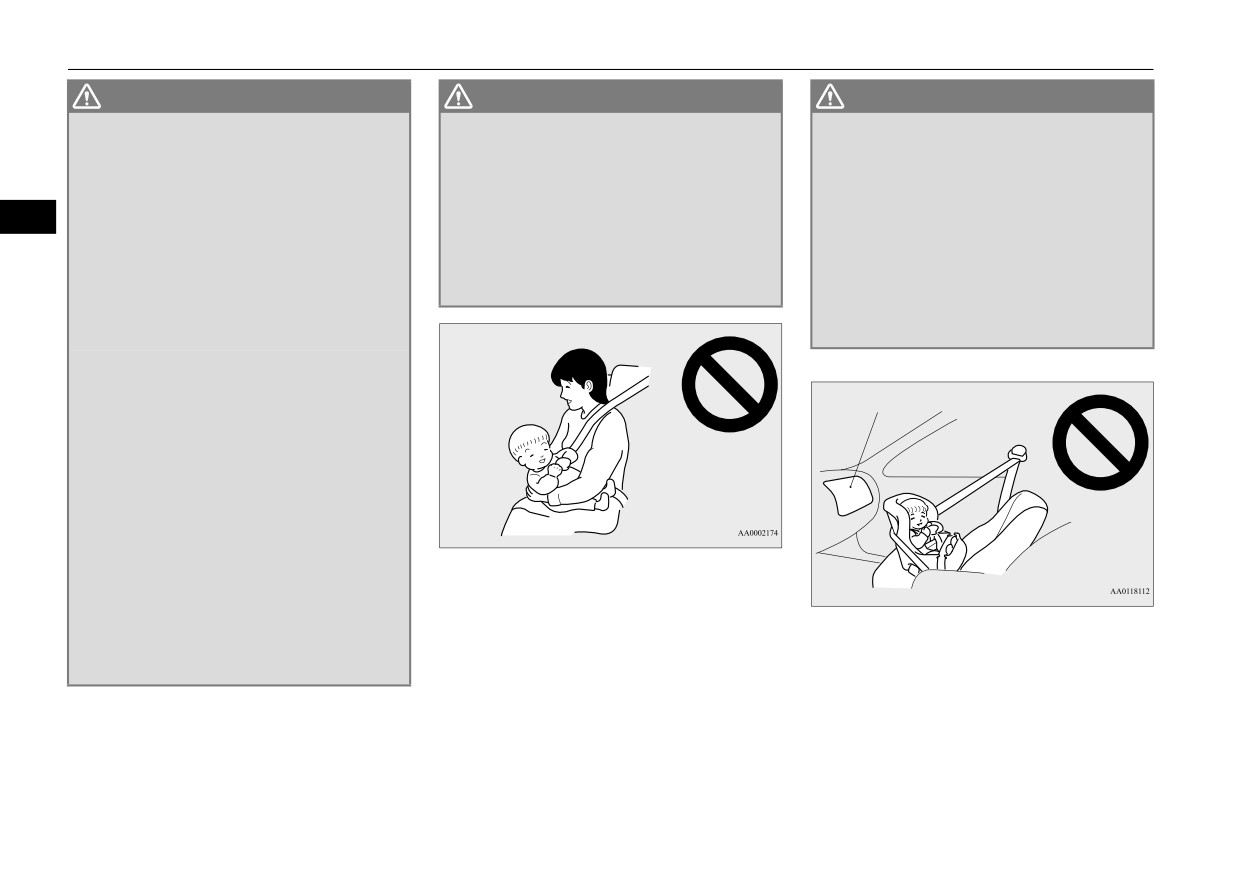
Child restraint systems
WARNING
WARNING
WARNING
z
All children must be seated in the rear
z
Never hold an infant or child in your arms
z
Your vehicle is also equipped with a front
seat, and properly restrained.
or on your lap when riding in this vehicle,
passenger’s airbag.
Accident statistics show that children of
even when you are wearing your seat belt.
Never put REAR-FACING CHILD
all sizes and ages are safer when properly
Never place any part of the seat belt you
RESTRAINT SYSTEMS or INFANT
restrained in the rear seat, rather than in
are wearing around an infant or child.
RESTRAINT SYSTEMS in the front pas-
4
the front seat.
Failure to follow these simple instructions
senger seat. This places the infant too
z
Be sure to select a child restraint system
creates a risk of serious injury or death to
close to the passenger’s airbag. During
that is appropriate not only for the child’s
your child in the event of an accident or
deployment of that airbag, the infant can
size and age but also for your vehicle.
sudden stop.
be seriously injured or killed. Rear-facing
Some child restraint systems may not fit
child restraint systems or infant restraint
your vehicle properly.
systems must only be used in the rear seat.
z
Any child who is too large to use a child
restraint system should ride in the rear
seat and wear the lap-and-shoulder belt
Airbag
properly. The shoulder belt must be posi-
tioned over the shoulder and across the
chest, not across their neck, and with the
lap belt positioned low on the child’s hips,
not across their stomach. If necessary, a
booster seat should be used to help achieve
a proper seat belt fit. Follow the booster
seat manufacturer’s instructions. Only use
a booster seat that is certified as comply-
ing with Federal Motor Vehicle Safety
Standards or Motor Vehicle Restraint Sys-
tems and Booster Seats Safety Regula-
tions.
4-16
Seat and restraint systems
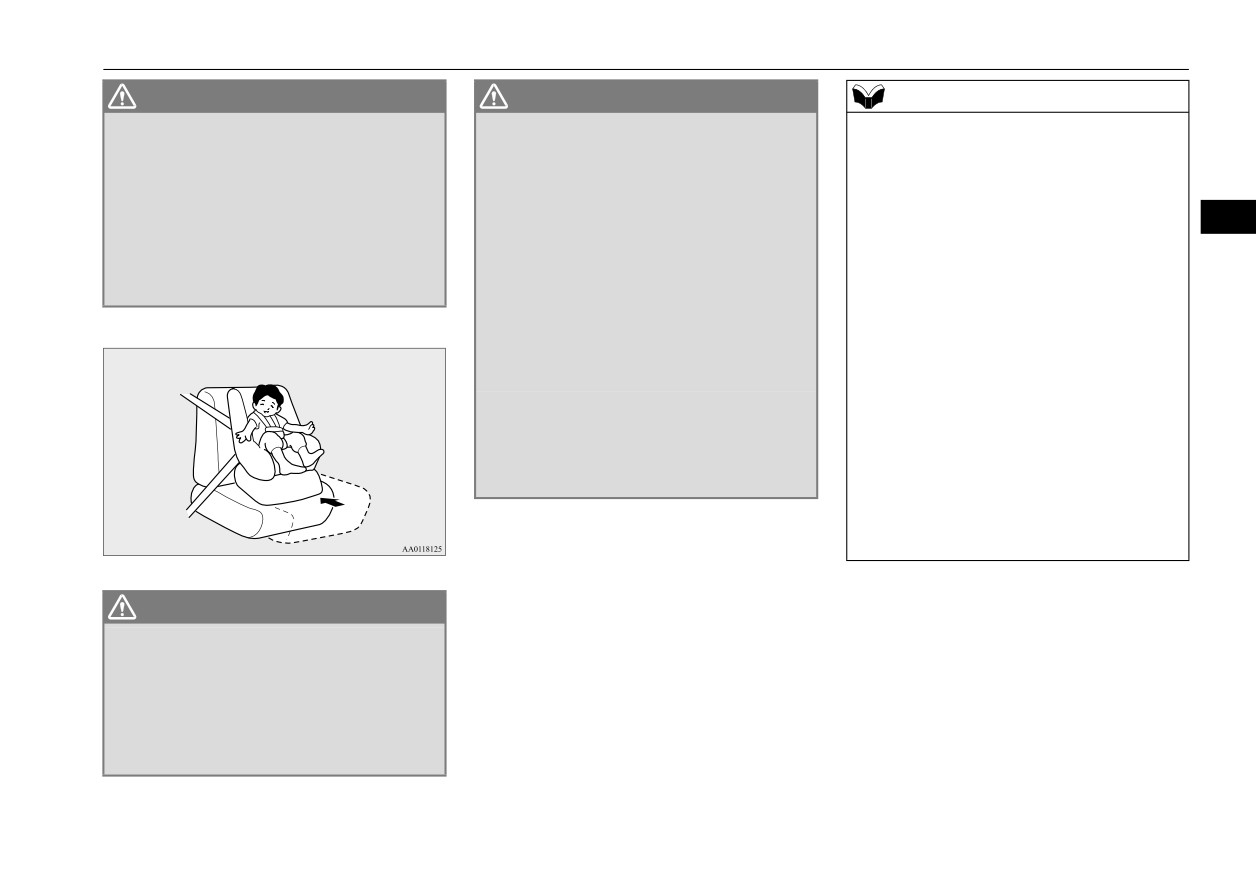
Child restraint systems
WARNING
WARNING
NOTE
z
FRONT-FACING CHILD RESTRAINT
z
When installing a child restraint system,
z
Before purchasing a child restraint system,
SYSTEMS should be used in the rear seat
follow the instructions provided by the
try installing it in the rear seat to ensure
whenever possible. If one must be used in
manufacturer and follow the directions in
proper fit. Due to the location of the seat belt
the front passenger seat, move the seat to
this manual. Failure to do so can result in
buckles and the shape of the seat cushion, it
the most rearward position and make sure
serious injury or death to your child in an
may be difficult to securely install some
4
the child stays in the child restraint sys-
accident or sudden stop.
manufacturer’s child restraint systems.
tem, properly restrained. Failure to follow
z
After installation, push and pull the child
If the child restraint system can be pulled
these instructions could result in serious
restraint system back and forth, and side
forward or to either side easily on the seat
injury or death to the child.
to side, to see that it is firmly secured. If
cushion after the seat belt has been tightened,
the child restraint system is not installed
choose another manufacturer’s child restraint
securely, it may cause injury to the child
system.
or other occupants in the event of an acci-
Depending on the seating position in the
dent or sudden stop.
vehicle and the child restraint system that
z
When not in use, keep your child restraint
you have, the child restraint system can be
system secured with the seat belt, or
attached using one of the following 2 meth-
remove it from the vehicle, in order to pre-
ods:
vent it from being thrown around inside
• Attach to the lower anchorage in the rear
the vehicle during an accident.
seat ONLY if the child restraint system is
compatible with the LATCH system (See
page 4-18).
• Attach to the seat belt (See page 4-22).
WARNING
z It is important to use an approved rear-
facing infant restraint until the infant is
one year old (unless the infant outgrows
the seat sooner). This allows the infant’s
neck and spine to develop enough to sup-
port the weight of their head in the event
of an accident.
Seat and restraint systems
4-17
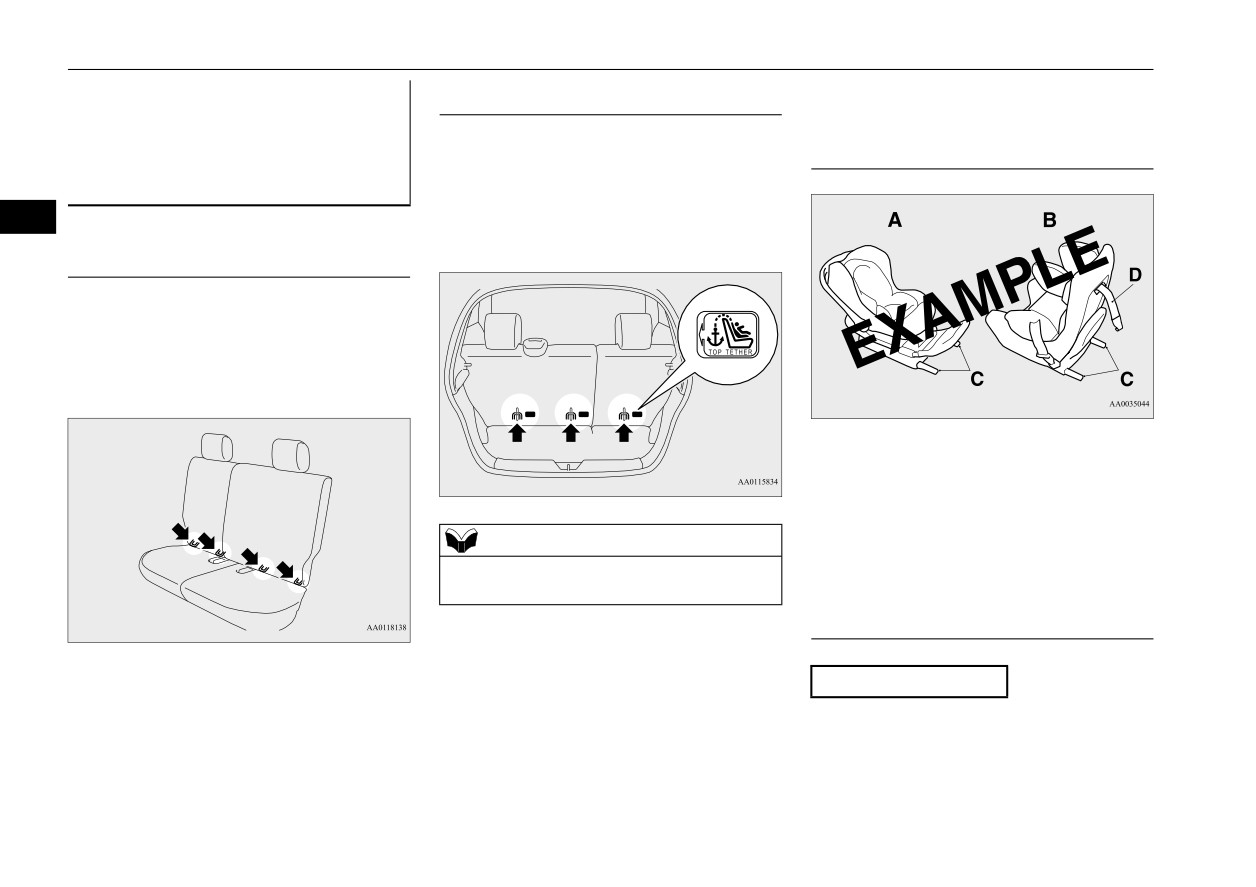
Child restraint systems
Installing a child restraint sys-
Tether anchor locations
Examples of child restraint sys-
N00418900190
tems compatible with the LATCH
tem using the LATCH (Lower
Your vehicle has 3 attachment points on the
system
Anchors and Tethers for chil-
back of the rear seatbacks. These are for
N00419000202
dren) system
securing a child restraint system tether strap
N00418800157
to each of the 3 rear seating positions in your
4
vehicle.
Lower anchor locations
The outboard seating positions in the rear seat
of your vehicle are equipped with lower
anchors for attaching child restraint systems
compatible with the LATCH system.
A- Rear-facing child restraint system
B- Front-facing child restraint system
C- Child restraint system lower anchor
connectors
D- Tether strap
NOTE
(These are only examples.)
z The attachments points are behind slits on
the seatback backboard cloth.
Using the LATCH system
N00419101356
Except for booster seat
1. In order to securely fasten the tether strap,
remove the head restraint from the loca-
tion where you wish to install the child
restraint system.
4-18
Seat and restraint systems
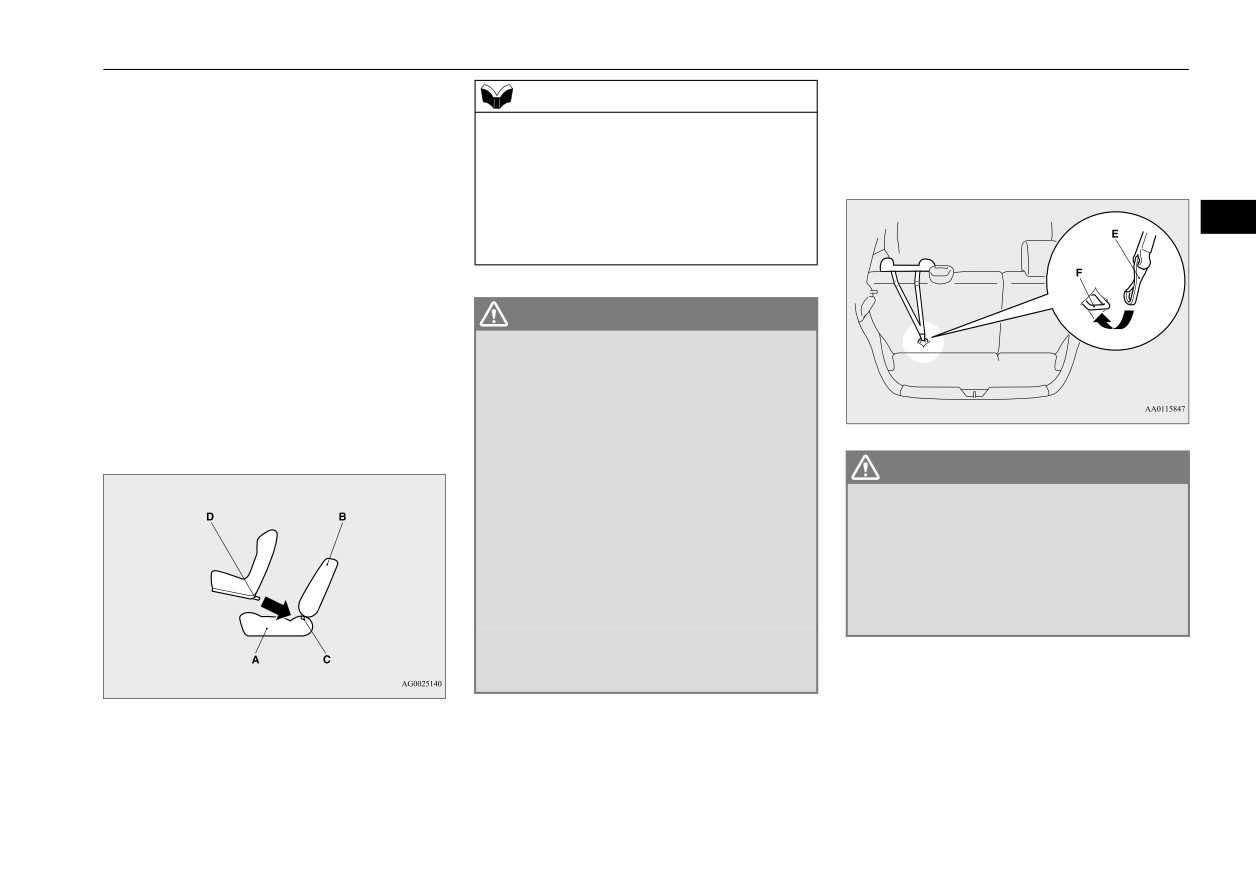
Child restraint systems
2. Open the gap a little between the seat
5. Open the slit on the backboard cloth of the
NOTE
cushion (A) and the seatback (B) with
seatback, latch the tether strap hook (E) of
z
In order to secure a child restraint system
your hand to locate the lower anchors (C).
the child restraint system to the tether
compatible with the LATCH system, you
3. Push the anchor connectors (D) on the
anchor bar (F) and tighten the tether strap
must use the lower anchor points in the out-
child restraint system into the lower
so it is securely fastened.
board positions of the rear seat. To secure a
anchors
(C) in accordance with the
child restraint system in the center position
instructions provided by the child restraint
4
of the rear seat, you must use the vehicle’s
system manufacturer.
center seat belt.
Remember, the lower anchors provided
with your vehicle are designed to secure
suitable child restraint systems compat-
WARNING
ible with the LATCH system in the out-
z
If there is any foreign material in or
board positions of the rear seats only.
around the lower anchors, remove it
The anchor connectors are NOT
before installing the child restraint sys-
designed to secure a suitable child
tem. Also, make sure the seat belt is away
restraint system in the center position
from, not looped through or otherwise
interfering with, the child restraint sys-
of the rear seat.
tem. If foreign matter is not removed
WARNING
and/or the seat belt interferes with the
z
Child restraint system tether anchors are
child restraint system, the child restraint
designed only to withstand loads from cor-
system will not be secured properly, could
rectly fitted child restraint systems.
detach and move forward in the event of
Under no circumstances are they to be
sudden braking or an accident, and could
used for adult seat belts, harnesses, or for
result in injury to the child or other vehi-
attaching other items or equipment to the
cle occupants.
vehicle.
z
When the vehicle is moving, do not adjust
the seat where the child restraint system is
6. Before putting your child in the restraint,
installed.
push and pull the restraint in all directions
A- Vehicle seat cushion
to be sure it is firmly secure. Do this
4. On a vehicle equipped with a rear shelf
B- Vehicle seatback
before each use. If the child restraint sys-
panel, remove the rear shelf panel from
C- Lower anchor
tem is not firmly secure, repeat steps 3
the vehicle. (Refer to “Rear shelf panel”
D- Connector
through 5.
on page 5-111.)
Seat and restraint systems
4-19
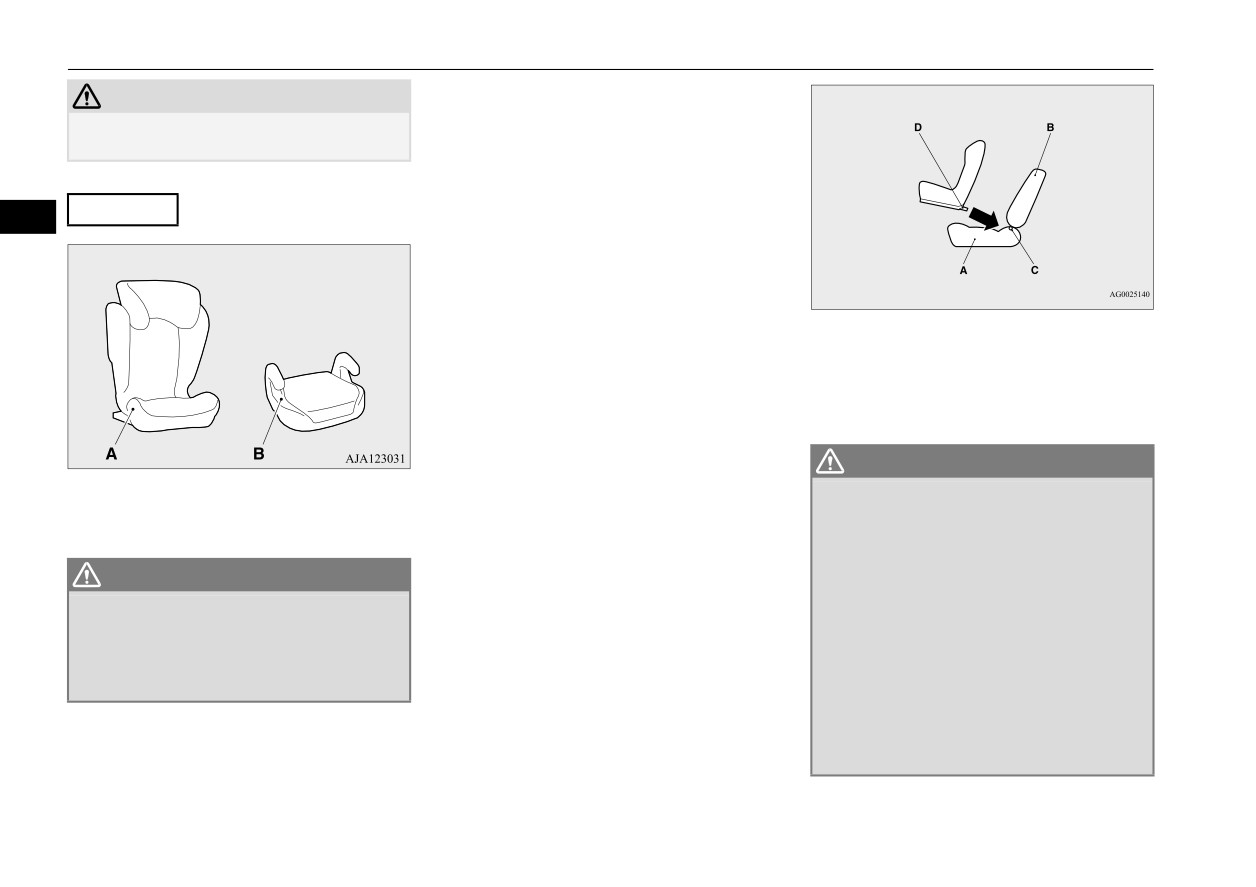
Child restraint systems
High back booster seat
CAUTION
z After removing the child restraint system,
1. In order to securely fasten the tether strap,
install the head restraint.
remove the head restraint from the loca-
tion where you wish to install the high
back booster seat.
Booster seat
4
2. Open the gap a little between the seat
cushion (A) and the seatback (B) with
your hand to locate the lower anchors (C).
3. Push the anchor connectors (D) on the
high back booster seat into the lower
A- Vehicle seat cushion
anchors
(C) in accordance with the
B- Vehicle seatback
instructions provided by the child restraint
C- Lower anchor
system’s manufacturer.
D- Connector
Remember, the lower anchors (C) pro-
vided with your vehicle are designed to
secure suitable high back booster seats
WARNING
compatible with the LATCH system in
A- High back booster seat
z
If there is any foreign
material
in
or
the outboard positions of the rear seats
B- Booster cushion
around the lower anchors, remove it
only. The anchor connectors are NOT
before installing the high back booster
designed to secure a suitable high back
seat. Also, make sure the seat belt is away
booster seat in the middle seating posi-
WARNING
from, not looped through or otherwise
tion of the rear seat.
interfering with, the high back booster
z To avoid injury to child, do not use the
seat. If foreign matter is not removed
lap/shoulder belt Automatic Locking
and/or the seat belt interferes with the
Retractor (ALR) child restraint installa-
high back booster seat, the high back
tion function when using a booster seat
booster seat will not be secured properly,
with the seat belts.
could detach and move forward in the
event of sudden braking or an accident,
and could result in injury to the child or
other vehicle occupants.
4-20
Seat and restraint systems
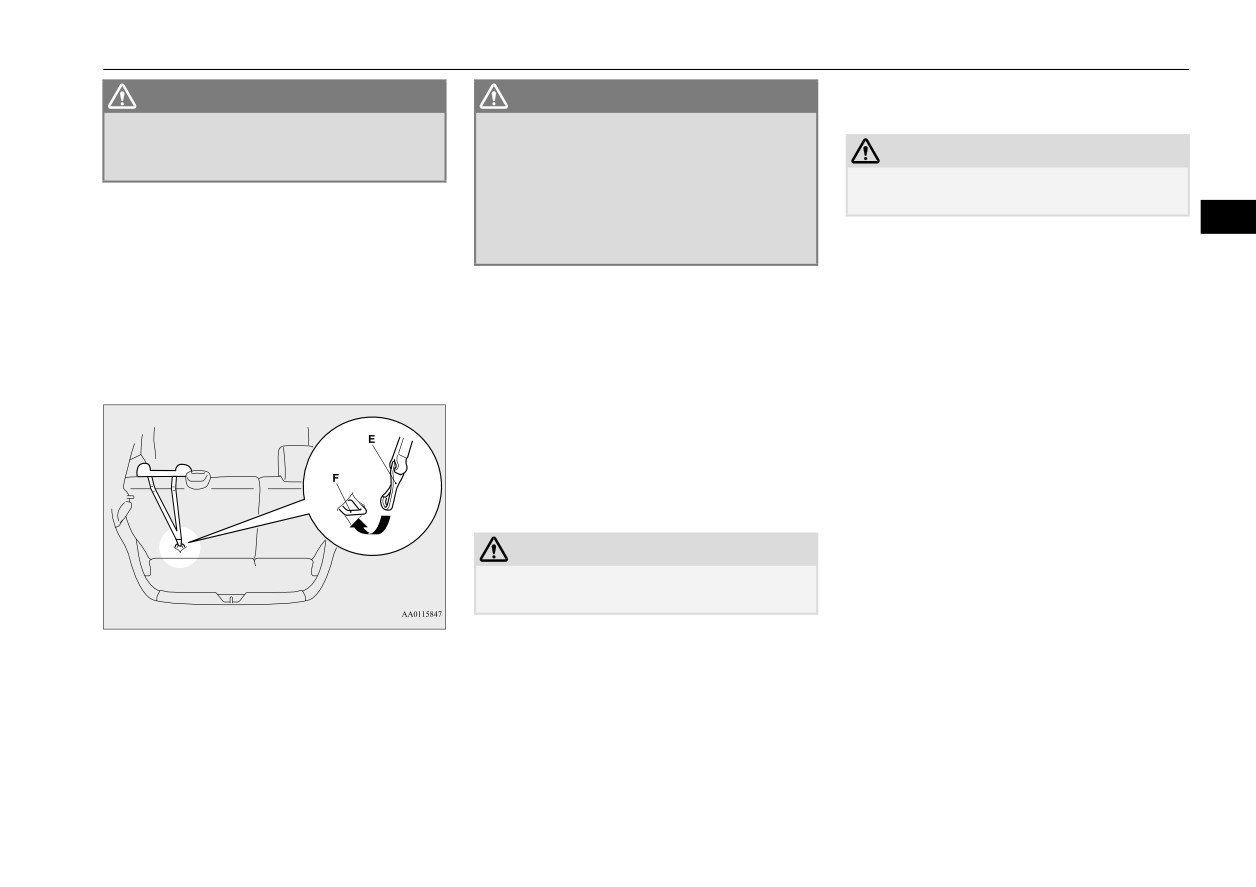
Child restraint systems
Booster cushion
WARNING
WARNING
z When the vehicle is moving, do not adjust
z Child restraint system tether anchors are
the seat where the high back booster seat
designed only to withstand loads from cor-
CAUTION
is installed.
rectly fitted child restraint systems.
z Do not remove the head restraint when
Under no circumstances are they to be
4. On a vehicle equipped with a rear shelf
installing a booster cushion.
used for adult seat belts, harnesses, for
panel, remove the rear shelf panel from
4
attaching other items, or equipment to the
the vehicle. (Refer to “Rear shelf panel”
vehicle.
1. Open the gap a little between the seat
on page 5-111.)
cushion (A) and the seatback (B) with
5. Open the slit on the backboard cloth of the
your hand to locate the lower anchors (C).
6. Before putting your child in the restraint,
seatback, latch the tether strap hook (E) of
2. Push the anchor connectors (D) on the
push and pull the high back booster seat in
the high back booster seat to the tether
booster cushion into the lower anchors
all directions to be sure it is firmly secure.
anchor bar (F) and tighten the tether strap
(C) in accordance with the instructions
Do this before each use. If the high back
so it is securely fastened.
provided by the child restraint system’s
booster seat is not firmly secure, repeat
steps 3 through 5.
manufacturer.
7. Sit the child in the high back booster seat.
Remember, the lower anchors (C) pro-
Fit the seat belt to the high back booster
vided with your vehicle are designed to
seat according to the child restraint sys-
secure suitable booster cushions com-
tem’s manufacturer.
patible with the LATCH system in the
outboard positions of the rear seats
CAUTION
only. The anchor connectors are NOT
designed to secure a suitable booster
z After removing the high back booster seat,
install the head restraint.
cushion in the middle seating position
of the rear seat.
Seat and restraint systems
4-21

Child restraint systems
3. Sit the child in the booster cushion.
from normal Emergency Locking Retractor
Fit the seat belt to the booster cushion
(ELR) mode, to Automatic Locking Retractor
according to the child restraint system’s
(ALR) mode. This means that when you pull
manufacturer.
the seat belt fully out of the retractor, the
retractor will switch to its ALR child restraint
WARNING
installation function. Always use the ALR
4
z
When using a child restraint in a rear
child restraint installation function when you
seating position, always review the
install a child restraint system using the seat
instructions provided with that restraint
belt.
to make sure it is compatible with this
vehicle and to understand how to properly
Children
12 years old and under should
A- Vehicle seat cushion
install it.
always be restrained in the rear seat, when-
B- Vehicle seatback
Child restraints, including booster seats,
ever possible, although the front passenger
C- Lower anchor
come in different sizes and configurations.
seat belt can also be converted to ALR mode.
Depending on where you place these child
D- Connector
restraints, and depending on their size and
configuration, you may not be able to
WARNING
access or properly use one or more adja-
z
When you install a child restraint system
WARNING
cent seat belt assemblies. If this occurs,
using the seat belt, always make sure the
z
If there is any foreign
material
in
or
the adjacent seating position or positions
retractor has been switched to the ALR
around the lower anchors, remove it
should not be used. Failure to use a seat
child restraint installation function. The
before installing the booster cushion. Also,
belt or improper use of a seat belt can
ALR function will keep the child restraint
make sure the seat belt is away from, not
result in serious injury or death should a
system tightly secured to the seat.
looped through or otherwise interfering
crash occur.
Failure to convert the retractor to the
with, the booster cushion. If foreign mat-
ALR function may allow the child
ter is not removed and/or the seat belt
restraint system to move forward during
interferes with the booster cushion, the
sudden braking or an accident, resulting
booster cushion will not be secured prop-
Installing a child restraint sys-
in serious injury or death to the child or
erly, could detach and move forward in
tem using the seat belt (with
other occupants.
the event of sudden braking or an acci-
emergency/automatic locking
dent, and could result in injury to the
child or other vehicle occupants.
mechanism)
z
When the vehicle is moving, do not adjust
N00407301612
the seat where the booster cushion is
With the exception of the driver, the seat belt
installed.
in all other seating positions can be converted
4-22
Seat and restraint systems

Child restraint systems
3. To activate the ALR child restraint instal-
5. After confirming that the belt is locked,
Installation
lation function, slowly pull the shoulder
grab the shoulder part of the belt near the
part of the belt all the way out of the
buckle and pull up to remove any slack
Except for booster seat
retractor until it stops. Then let the belt
from the lap part of the belt allowing the
feed back into the retractor.
slack to feed into the retractor. Remember,
1. Place the child restraint system on the seat
if the lap belt portion is not tight, the child
where you wish to install it.
restraint system will not be secure. It may
4
To help assure proper fitting of the child
help to put your weight on the child
restraint system, always remove the head
restraint system and/or push on its seat-
restraint.
back while pulling up on the belt (See
2. Route the seat belt through the child
illustration).
restraint system according to the instruc-
tions provided by the child restraint sys-
tem’s manufacturer. Then insert the seat
belt latch plate into the buckle. Make sure
you hear a “click” when you insert the
latch plate into the buckle.
4. After the belt has retracted, tug on it.
If the belt is in the ALR function, you will
not be able to pull it out. If the webbing
can be pulled out from retractor, the ALR
function has not been activated and you
will need to repeat steps 3 and 4.
If your child restraint system requires the use
of a tether strap, fasten the tether strap in
accordance with the following procedures.
6. On a vehicle equipped with a rear shelf
panel, remove the rear shelf panel from
the vehicle. (Refer to “Rear shelf panel”
on page 5-111.)
Seat and restraint systems
4-23